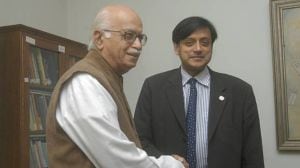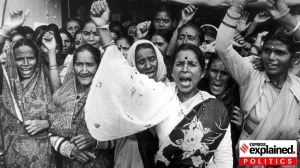A mini Gujarat in Maharashtra
Three major riots within just eight months: Malegaon, Nandurbar and Jamner, all in north Maharashtra. Three common factors: Blunders by the ...

Three major riots within just eight months: Malegaon, Nandurbar and Jamner, all in north Maharashtra. Three common factors: Blunders by the police, communal polarisation and local politics.
The increase in the frequency of riots in one of the most industrialised states rings an alarm bell, which seems to be going unheard in the lobbies of the polity and the bureaucracy. But the signal is loud and clear: Allowing emotions to override logic in the land of incompetent police and selfish polity is dangerous for the country.
Of the three, communal polarisation seems to be the most potent; it is certainly at its strongest since the Partition. The air is so thick with mutual hatred that a street fight over playing cards (Nandurbar), an altercation with the police over distribution of handbills (Malegaon) and the beating up of a suspect by a police official in public (Jamner) bear the seeds of a full fledged riot.
In Malegaon and Jamner, the gestures of local politicians — Nihal Ahmed (JD Secular) and Girish Mahajan (BJP) respectively — also acted as a catalyst for violence and arson.
In all three places, the police failed either to gather enough intelligence to pre-empt a communal flareup or to control it effectively. In Malegaon, the police ignored minor incidents of communal tension a month before the riots began. Also, their handling of the youth distributing handbills seeking a boycott of American goods during the Friday Namaz was inept at best: They allegedly snatched his handbills and tried to shoo him away, overlooking the fact that communal tempers had been heightened in the town by a morcha organised by former local MLA and Janata Dal (Secular) leader Nihal Ahmed to protest against the US attack on Afghanistan a week earlier.
In Jamner, too, blunders by police allegedly contributed to the communal frenzy. Tension had been brewing in the town since June 7, when a dead pig was reportedly found in the Shahi Masjid. A week later, the silver eyeballs of two Hanuman idols reportedly went missing in Jamner and in nearby Pahur. On June 18, two suspects, Ratnakar Padmakar Joshi and Dilip Sable, were taken into custody in the idols case. A police official, Rajkumar Chaphekar, publicly beat up Sable in Gandhi Chowk area, attracting crowds.
Several local residents, including the local MLA, Girish Mahajan, intervened and asked the officer to set Sable free, claiming that Joshi (who had named Sable as his accomplice) was mentally retarded and could not be taken seriously. The officer released Sable, and, in reaction, a mob went on the rampage.
Intelligence failure also played an important part in the Jamner riots. The police reportedly did not take adequate precautions after the pig incident. Till date, no breakthrough has been achieved in the case and, in fact, it is not known whether the incident actually took place since the police say by the time they went there, the masjid had been cleaned up.
The police also failed to believe local residents who reported movement of strangers in the town and women and children of a particular community leaving the town a week earlier.
In Malegaon, Nihal was reportedly politically frustrated following his defeat in the last assembly elections by his bete noir, Shaikh Rashid of the Congress. Robbed of power after six terms, Nihal was reportedly keen to consolidate his home turf.
In Jamner, Mahajan lost some ground recently when some of his minority community followers defected to the NCP on the eve of the Zilla Parishad polls. Hence, when Nihal organised an anti-US rally (albeit touching the religious sentiments of Muslims) in Malegaon, and Mahajan intervened to insist on the release of a suspect being beaten up by a police official in Jamner, they may have just wanted to consolidate their positions among voters, or to play God, but, their intentions were nevertheless questionable. Now, following the recovery of the Hanuman eyeballs from Joshi and Sable, Mahajan’s claims stand shattered.
The situation in Nandurbar is slightly different in the sense that no political figure seems to be directly responsible in whipping up communal passions. But here too, policing was apparently not a priority area. After the 1999 riots, a police station was promised in the Maliwada area. A chowki was created but it was abandoned after six months. A police station is yet to come up in the most sensitive spot in the town: A 10,000-strong Hindu locality surrounded from all sides by the Kali Masjid area.
The Nandurbar riots, too, could possibly have been averted had the local police acted promptly on a complaint filed by a Muslim youth who was beaten up by some local Bhil tribals while playing cards on May 12. No action followed, and the next morning, the mobs went berserk.
The Malegaon riots of October 2001 were historical because 13 lives were lost (the largest number ever) and the arson spread for the first time in surrounding villages and towns. Apart from the Malegaon casualties, the riots have claimed two lives in Nandurbar and seven in Jamner.



- 01
- 02
- 03
- 04
- 05




























